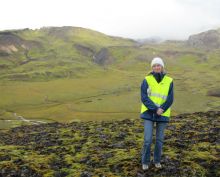This post was originally published in the Outdoor Alliance blog. Learn more at outdooralliance.org.
Guest post by Allyson Anderson Book, Executive Director of American Geosciences Institute | @AAndersonBook
As a geoscientist, I am frequently asked about why I chose my profession. My answer is deeply rooted in a sense of exploration and adventure – the excitement of getting into the field, whether by foot or boat – to interpret natural Earth systems.
The moment that I realized that I would be a geoscientist happened when I was assisting a professor out in the Wind River Range, WY. We were above the treeline taking measurements and acquiring soil and rock samples to help resolve the timing and extent of the last glacial event in the area. This first field adventure was a catalyst for me; it was physically grueling and mentally stimulating. It represented a spiritual awakening for me – moving me out of a career in music to pursue a future as a geoscientist. It was the combination of being out in the field, experiencing the adventure and excitement of field geology, that transformed me into an avid outdoor enthusiast.
It is over two decades since that pivotal field experience and my love of the outdoors has not diminished. My life has shifted remarkably from being a field scientist to that of being an “armchair geoscientist.” However, I take every opportunity to get outside to go paddling or hiking in an exploration of our Earth systems. The need to get outside is intrinsic in all of us, we just need to catalyze that feeling and – per the Nike slogan – “just do it.”
Some of the best areas to see Earth systems and resources reside in our Nation’s public lands. Recently, Secretary Zinke undertook a review of national monuments pursuant to President Donald Trump’s recent executive order. Under Secretary Zinke’s direction, the Department of the Interior is seeking public comments related to 27 National Monuments, including five Marine National Monuments.
My organization is deeply concerned by any attempt to reduce the status or size of any National Monument or Park, but particularly the Bears Ears National Monument. Bears Ears was established last year in large part due to its outstanding fossil record. Many of the fossils from Bears Ears are the only examples of their kind that exist in the country or the world, including newly discovered species of extinct fish, amphibians, mammal-relatives, and reptiles. The area’s rich fossil record, much of which has yet to be explored, is crucial to understanding how dinosaurs once dominated land ecosystems, how vertebrate life transitioned from sea to land, and how our human ancestors evolved.
Bears Ears is one of the most significant cultural landscapes in the United States. Native American tribes populated this area for hundreds of generations. Their cultural history is present in the form of abundant rock art, dwellings, and other artifacts that reflect its historical and cultural significance. Many Native Americans still consider the land profoundly sacred and visit the area on a regular basis to perform ceremonies and connect with their ancestors.
In addition to its stunning landscape and extraordinary paleontological and archaeological resources, Bears Ears provides a major source of economic opportunity. Its compelling geologic features attract visitors from across the globe who wish to experience the natural wonders of the land, and partake in recreational activities such as hiking, fishing, rock climbing, and whitewater rafting. But perhaps more importantly, the unique fossil record and geological history present at Bears Ears embody the collective imagination and interest of millions of scientists and serve as an inspiration to people of all ages.
I invite you to get out and see Bears Ears, or the public lands near you, to celebrate the rich diversity of our Earth systems…whether by foot, kayak, snowshoe, or on climbing ropes. Share your experience with me on Twitter or with your member of Congress, to ensure that all of our voices are heard.
Written comments for Bears Ears and all of the other national monuments under review may be submitted online here. Comments must be submitted by July 10 to ensure consideration.
Update: As of June 26, eleven more National Marine Sanctuaries and Marine National Monuments have been placed under review. Comments for these eleven additional sites must be submitted online by July 26 to ensure consideration.

